West Coast e-Postcard #2
from Our West Coast Train Triangle
September 18 to October 18, 2010
Hi All --
WEST COAST TRIANGLE: SIDE 2
We Know Why It’s Called a RAIN Forest
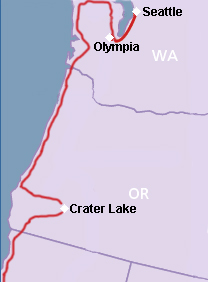
Off we go, just the two of us (after dropping the sisters off at SeaTac
airport), on to the wilds of the Olympic peninsula. Our goals: drive down
Highways 101 and 1 along the coast from Olympic Peninsula to San Diego
(with a slight detour) taking at least one hike and one photograph per
day. Reality: Usually more than one hike and over 100 photos a day (it’s only
digital, says Tim).
We had room reservations only in the south of the state, so we really were
on our own. The first goal was Hurricane Ridge, a mountain viewpoint in
the north of Olympic National Park (NP). It was cold, rainy, and foggy
all the way up. But we drove high enough (5200 feet) to break through the
clouds and into a sunny panorama of mountains. In the winter, there is
downhill skiing and snowboarding here. All we were missing was the snow;
otherwise the temperature would have been right! With dreams of sunny days
(and thousands of potential photo opportunities for Tim), we spent the
night in Port Angeles, at the northern central top of the state.
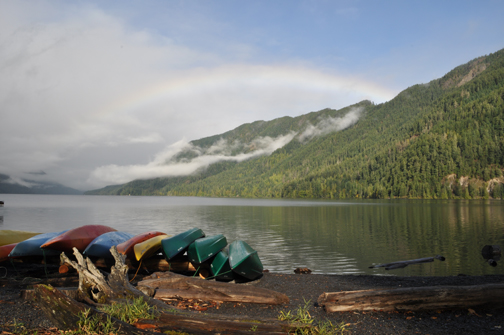
The next day started with a waterfall walk to beautiful Marymere Falls,
where we experienced the temperate rain forest, intermittent showers and a
rainbow over the nearby lake. One thing about this trip, patience with
the rainy weather often came with a rainbow reward. The rain forest mixture of
trees, ferns, and mosses covers everything and exists only a few places in
the world. As one guidebook stated, the forest is so dense, “it makes the
very air seem green.”
A short weather note: Tim refers to Di as the “weather goddess”.
Actually, it is the reverse. If the sun is out and she puts on her
sunglasses, it pretty much guarantees clouds will shortly appear. Taking
off the sunglasses usually brings back the sun.
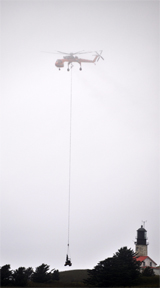
Next was Cape Flattery, the claimed most northwestern tip of the
continental U.S. It is that little corner of your U.S. puzzle that always
got bent. It rained continuously as we drove the winding road through
Native American lands to the Cape. The closer we got, the harder the rain
fell and the wind blew. So we put on our jackets and raincoats (and hats
and gloves) to trudge through the rainforest (aptly named here) until it
opened out into Pacific Ocean. Just then the clouds temporarily cleared
enough for a few photos of Tatoosh Island across from the cape (Di’s
sunglasses were off). Then we heard a helicopter. A local guide
explained that the crane used to repair something on the island was being airlifted
in parts back to the mainland. It was interesting to see the body of the
large crane swinging by cable from the helicopter over the water.
The day ended in the strange town of Forks, WA. For those of you who
don’t know about the Twilight craze, it is a series of romantic books (and
resulting movies) about teenaged vampires for teenaged readers (mostly
girls). In the books, the characters (human and vampire) live in Forks.
The author had not been to Forks before writing the books, but that didn’t
stop the town taking advantage of the current Twilight madness. There
were Twilight menus in restaurants, Twilight posters, Twilight shops, tours of
houses that kind of resembled the fictional ones in the books, and so on,
ad nauseam. The motel we stayed at even had a Twilight room decorated in
black and red (no, we didn’t sleep there). It was enough to suck the life
out of you (sorry, couldn’t resist!).
Deadly Logs and the Winter of 2009
After a hike through a couple of nature trails the next day, we arrived at
Ruby Beach along the Pacific. Along the downhill trail there were
warnings about deadly logs in the water. Deadly logs?
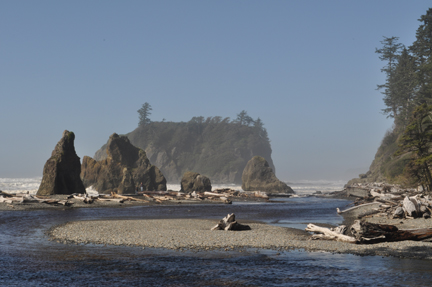 This became clear when we
saw the huge trees that had been piled up on the shore. During storms,
trees on the cliff overhangs or along rivers would end up in the ocean and
eventually wash up on the beach. People have been hurt and killed by
these logs while swimming in the ocean. The trees were so piled up in some
areas, that you would have to climb over them. Photo opportunities
abounded when you combined the ocean, the deadly trees, and the huge sea
stacks (enormous rock formations in the water).
This became clear when we
saw the huge trees that had been piled up on the shore. During storms,
trees on the cliff overhangs or along rivers would end up in the ocean and
eventually wash up on the beach. People have been hurt and killed by
these logs while swimming in the ocean. The trees were so piled up in some
areas, that you would have to climb over them. Photo opportunities
abounded when you combined the ocean, the deadly trees, and the huge sea
stacks (enormous rock formations in the water).
Later we got to our NP accommodation, the Lake Quinault Lodge. Built in
1926, it had architecture similar to Glacier, with large post and beam
construction, and a dignified but rustic interior. We took a hike to a
nearby creek and were surrounded by massive piles of fallen trees; the
trail look recently cleared, but there were few trees along the trail that
were upright. We later learned that this was the great windstorm of
December, 2009. It hit all along the Pacific Northwest coast, taking down
large areas of the forests like a giant with a lawnmower.
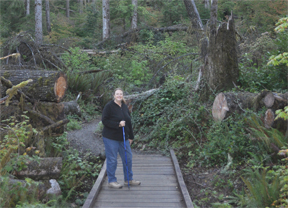 A local said
there were 120 mph sustained winds for 26 hours (he had a big tree go
through his restaurant’s roof). It took tremendous effort to not only
clean up private properties, but to get the numerous trails back into
walking condition. Up before the sun the next morning to take a waterfall
hike by the lodge. Again, we saw fallen trees, but got great photos as
the sun rose. Then across the state line to Oregon.
A local said
there were 120 mph sustained winds for 26 hours (he had a big tree go
through his restaurant’s roof). It took tremendous effort to not only
clean up private properties, but to get the numerous trails back into
walking condition. Up before the sun the next morning to take a waterfall
hike by the lodge. Again, we saw fallen trees, but got great photos as
the sun rose. Then across the state line to Oregon.
The Land of Umpqua
A few years ago Tim, Di and our friend Rick Hamill drove down part of the
Oregon coast during our spring break, so we were in familiar territory.
However, we saw whole hillsides of trees taken down. We knew we were in
lumbering country, but had to laugh when we saw the signs put up by
Weyerhaeuser (paper company) that stated it wasn’t them, but Mother Nature
who took down the trees and left such a mess. Later on, you knew the
hillside was lumbered when there were few, if any, standing trees and only
stumps and brush on the ground.
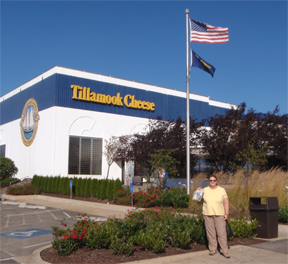 To give the lumber companies credit, we
did see some replanted areas, but when foresters use the term “clearcut”,
they aren’t kidding. It was a little depressing, but how else would we
have our paper and building materials?
To give the lumber companies credit, we
did see some replanted areas, but when foresters use the term “clearcut”,
they aren’t kidding. It was a little depressing, but how else would we
have our paper and building materials?
A required stop in this area is the huge Tillamook Cheese factory, home of
the squeaky cheese curds (like those in Wisconsin). Alas! They were out
of stock! Di was crushed, until Tim found out there was a hidden
stash….at the local feed store. So off we went to buy the only thing in the store
that could be eaten by humans.
Squeaking along Hwy 101 which followed the Umpqua River, we saw several
lighthouses along the coast. A disappointment was when we revisited the
Cape Meares Lighthouse. During our previous trip, Tim had taken a
wonderful photo of the Fresnel lens at sunset…this lens is the beautiful
arrangement of thick, handmade optical glass pieces through which the old
oil lanterns beamed out of the lighthouse.
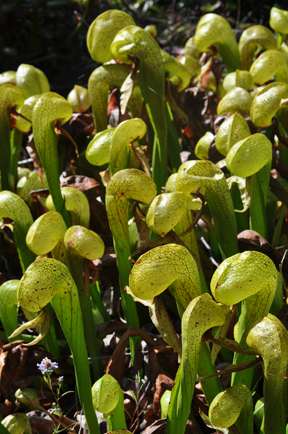 The lens was gone. We later
heard that two young guys shot it to pieces for fun…and that one piece
of such glass in another lighthouse cost $25,000 to replace. So this
vandalism was costly in many ways. We’d like to see these guys doing
community service the rest of their lives!
The lens was gone. We later
heard that two young guys shot it to pieces for fun…and that one piece
of such glass in another lighthouse cost $25,000 to replace. So this
vandalism was costly in many ways. We’d like to see these guys doing
community service the rest of their lives!
On a happier note, we pulled into the Darlingtonia natural area, not
knowing what we would find. To our glee, it was a small area named after
the carnivorous plants there. They looked a lot like our pitcher plants
in Michigan, but were easily 18 inches high. There were hundreds of them, in
various states of growth. There were very few insects about and the
plants looked well fed. We need a couple of those around our house in the
summer, especially if they attract fruit flies!
Eight Waterfalls, 4.9 Miles of Walking and a Couple of Aleves

We left Hwy 101 for a detour to Crater Lake and Oregon Caves. The scenic
inland route was also known as the Waterfall Highway. Armed with the
National Park’s “Guide to Thundering Waters”, we aimed to see as many
waterfalls as possible. Now, by the end of summer, the falls are no
longer thundering, but we were unaware that waterfalls could come in so many
shapes and sizes. Long, short, wide, narrow, divided horizontally or
vertically, all eight we saw were beautiful in their own ways. At one
site we looked down several feet where two rivers met. Next to us was a sign,
taller that Tim that showed where the flood waters of 1964 reached. We
heard of and saw the effect of this flood throughout Oregon with destroyed
buildings; rivers rerouted, and moved trails.
Oregon rates its trails as easy, moderate or strenuous. Most of the
waterfall trails were easy or moderate, but one had a rugged, narrow,
rocky uphill climb (with the downhill just as treacherous). This just had to be
rated strenuous (if there was a very strenuous, we would have labeled it
that!) As we downed the Aleve later that evening, we realized the trails
totaled 4.9 miles in length…..and that our legs felt not just used, but
abused. Tim would say it was good for us, which it was, but I can see
that getting in shape means more Aleve in the future! (I know our hardy
relatives, the Kings, would consider this a “walk in the park”, but for us
it was a milestone).
Getting to the Lake of Crater Lake or It’s all Uphill From Here
Wow! This place takes your breath away. As you drive up to the rim of the
caldera of Crater Lake, you get a glimpse of this huge body of very blue,
clear, calm water, surrounded by steep sided rocks. There is only one
island (actually the result of a volcanic eruption) and one rock formation
in this 4 by 6 mile oval lake. We drove around the lake on the Rim Road
(33 miles) with many stops for short walks and photos. By last count, Tim
took 15 series of panoramic photos of the lake (that’s 15 series of photos,
not just 15 photos) plus lots of extras.
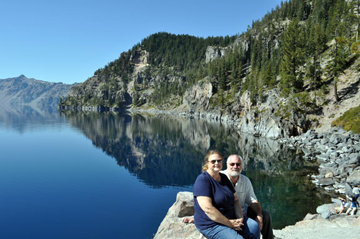 The high point (or low point
depending on your view) was the walk down to the lake’s edge, only
possible at one place along the rim. The Cleetwood Trail was 1.1 miles down in a
series of switchbacks and one long hot dusty trail. At the bottom of the
trail (see attachment), we saw some (foolish) folks jump off high rocks
into the very cold water. Di settled for just dipping her hands in the
lake….that was cold enough.
The high point (or low point
depending on your view) was the walk down to the lake’s edge, only
possible at one place along the rim. The Cleetwood Trail was 1.1 miles down in a
series of switchbacks and one long hot dusty trail. At the bottom of the
trail (see attachment), we saw some (foolish) folks jump off high rocks
into the very cold water. Di settled for just dipping her hands in the
lake….that was cold enough.
What comes down must go up. So, we trudged up the trail taking about an
hour, with frequent rest breaks required by Di. She is convinced that the
uphill was a longer distance, but the laws of physics are against her. We
finally made it to the top (and the car), hot and sweaty and tired; giving
this trail five stars on the strenuous scale.
We relaxed that night at the Crater Lake Lodge (another classic post and
beam NP lodge) watching the sun go down and the rocks turn pink for a few
minutes. The sky that night was clear, with so many stars and the Milky
Way viewable. This is most awesome and relaxing place (when you aren’t hiking
uphill).

Oregon Underground
Our next destination was Oregon Caves with a stay at a chalet maintained
by the local area. As far as caves go, Oregon Caves are neither the
biggest nor the most colorful, but the tour was very well done and the caves were
made of marble, not the usual limestone.
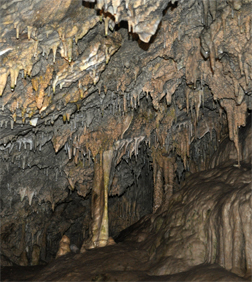 There are warnings on all the
literature and all over the Ranger’s Center that the cave tour was
strenuous (there’s that word again) and included 590 steps. After Crater
Lake, however, this one was almost a piece of cake. We got into the area
early and caught one of the last tours of the day. Tim and Di really enjoy
going through caves and here we had to walk bent over and climb down a
ladder bent backwards (like doing the limbo) due to the narrow passages.
At one point, the ranger turned off all the lights putting us in total
darkness. You really cannot see your face before your hand…kind of
creepy.
There are warnings on all the
literature and all over the Ranger’s Center that the cave tour was
strenuous (there’s that word again) and included 590 steps. After Crater
Lake, however, this one was almost a piece of cake. We got into the area
early and caught one of the last tours of the day. Tim and Di really enjoy
going through caves and here we had to walk bent over and climb down a
ladder bent backwards (like doing the limbo) due to the narrow passages.
At one point, the ranger turned off all the lights putting us in total
darkness. You really cannot see your face before your hand…kind of
creepy.
There were such wonderful formations in the cave, we really didn’t notice
the steps that much. Besides, they were not all uphill!
Unusual/Funny Things We Have Seen
* The towns of Remote, Trail, Wonder, and Happy Camp in Oregon. We may
need to visit that last one.
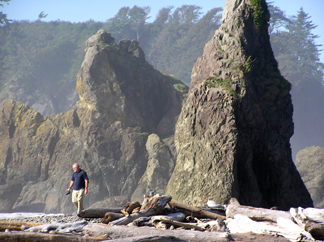
* A poster at a 76 gas station titled “Child’s Guide to Splattered Bugs”
with pictures of bugs smashed on the windshield identified with their
common and scientific names.
* Hotel soap that is shaped like a regular bar, but has a large oval hole
in the middle. The claim is that it wastes less soap. The hole is about
the size of the soap you leave after a couple of days in a motel.
We have to say, we really enjoyed Oregon. They have great signage on
their roads, have a very visible and user friendly statewide effort to
recycle and conserve resources. They also have frequent restrooms at the
trailheads (not all flush, but sometimes you don’t even care!). The folks
are friendly and the mountains, rivers, ocean, and forests are beautiful.
Now it is off to California, land of avocados and expensive gasoline.
Thanks for reading.
-- Di & Tim
 This became clear when we
saw the huge trees that had been piled up on the shore. During storms,
trees on the cliff overhangs or along rivers would end up in the ocean and
eventually wash up on the beach. People have been hurt and killed by
these logs while swimming in the ocean. The trees were so piled up in some
areas, that you would have to climb over them. Photo opportunities
abounded when you combined the ocean, the deadly trees, and the huge sea
stacks (enormous rock formations in the water).
This became clear when we
saw the huge trees that had been piled up on the shore. During storms,
trees on the cliff overhangs or along rivers would end up in the ocean and
eventually wash up on the beach. People have been hurt and killed by
these logs while swimming in the ocean. The trees were so piled up in some
areas, that you would have to climb over them. Photo opportunities
abounded when you combined the ocean, the deadly trees, and the huge sea
stacks (enormous rock formations in the water).



 A local said
there were 120 mph sustained winds for 26 hours (he had a big tree go
through his restaurant’s roof). It took tremendous effort to not only
clean up private properties, but to get the numerous trails back into
walking condition. Up before the sun the next morning to take a waterfall
hike by the lodge. Again, we saw fallen trees, but got great photos as
the sun rose. Then across the state line to Oregon.
A local said
there were 120 mph sustained winds for 26 hours (he had a big tree go
through his restaurant’s roof). It took tremendous effort to not only
clean up private properties, but to get the numerous trails back into
walking condition. Up before the sun the next morning to take a waterfall
hike by the lodge. Again, we saw fallen trees, but got great photos as
the sun rose. Then across the state line to Oregon.
 To give the lumber companies credit, we
did see some replanted areas, but when foresters use the term “clearcut”,
they aren’t kidding. It was a little depressing, but how else would we
have our paper and building materials?
To give the lumber companies credit, we
did see some replanted areas, but when foresters use the term “clearcut”,
they aren’t kidding. It was a little depressing, but how else would we
have our paper and building materials?
 The lens was gone. We later
heard that two young guys shot it to pieces for fun…and that one piece
of such glass in another lighthouse cost $25,000 to replace. So this
vandalism was costly in many ways. We’d like to see these guys doing
community service the rest of their lives!
The lens was gone. We later
heard that two young guys shot it to pieces for fun…and that one piece
of such glass in another lighthouse cost $25,000 to replace. So this
vandalism was costly in many ways. We’d like to see these guys doing
community service the rest of their lives!

 The high point (or low point
depending on your view) was the walk down to the lake’s edge, only
possible at one place along the rim. The Cleetwood Trail was 1.1 miles down in a
series of switchbacks and one long hot dusty trail. At the bottom of the
trail (see attachment), we saw some (foolish) folks jump off high rocks
into the very cold water. Di settled for just dipping her hands in the
lake….that was cold enough.
The high point (or low point
depending on your view) was the walk down to the lake’s edge, only
possible at one place along the rim. The Cleetwood Trail was 1.1 miles down in a
series of switchbacks and one long hot dusty trail. At the bottom of the
trail (see attachment), we saw some (foolish) folks jump off high rocks
into the very cold water. Di settled for just dipping her hands in the
lake….that was cold enough.

 There are warnings on all the
literature and all over the Ranger’s Center that the cave tour was
strenuous (there’s that word again) and included 590 steps. After Crater
Lake, however, this one was almost a piece of cake. We got into the area
early and caught one of the last tours of the day. Tim and Di really enjoy
going through caves and here we had to walk bent over and climb down a
ladder bent backwards (like doing the limbo) due to the narrow passages.
At one point, the ranger turned off all the lights putting us in total
darkness. You really cannot see your face before your hand…kind of
creepy.
There are warnings on all the
literature and all over the Ranger’s Center that the cave tour was
strenuous (there’s that word again) and included 590 steps. After Crater
Lake, however, this one was almost a piece of cake. We got into the area
early and caught one of the last tours of the day. Tim and Di really enjoy
going through caves and here we had to walk bent over and climb down a
ladder bent backwards (like doing the limbo) due to the narrow passages.
At one point, the ranger turned off all the lights putting us in total
darkness. You really cannot see your face before your hand…kind of
creepy.
